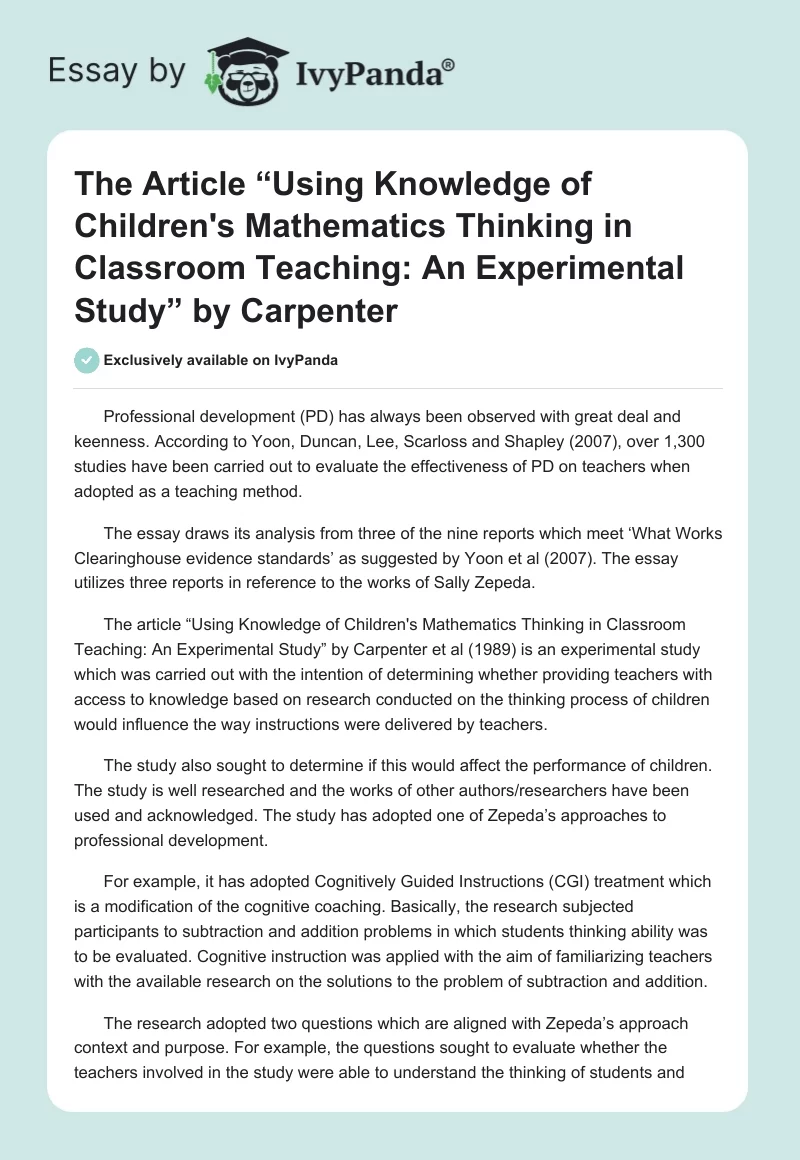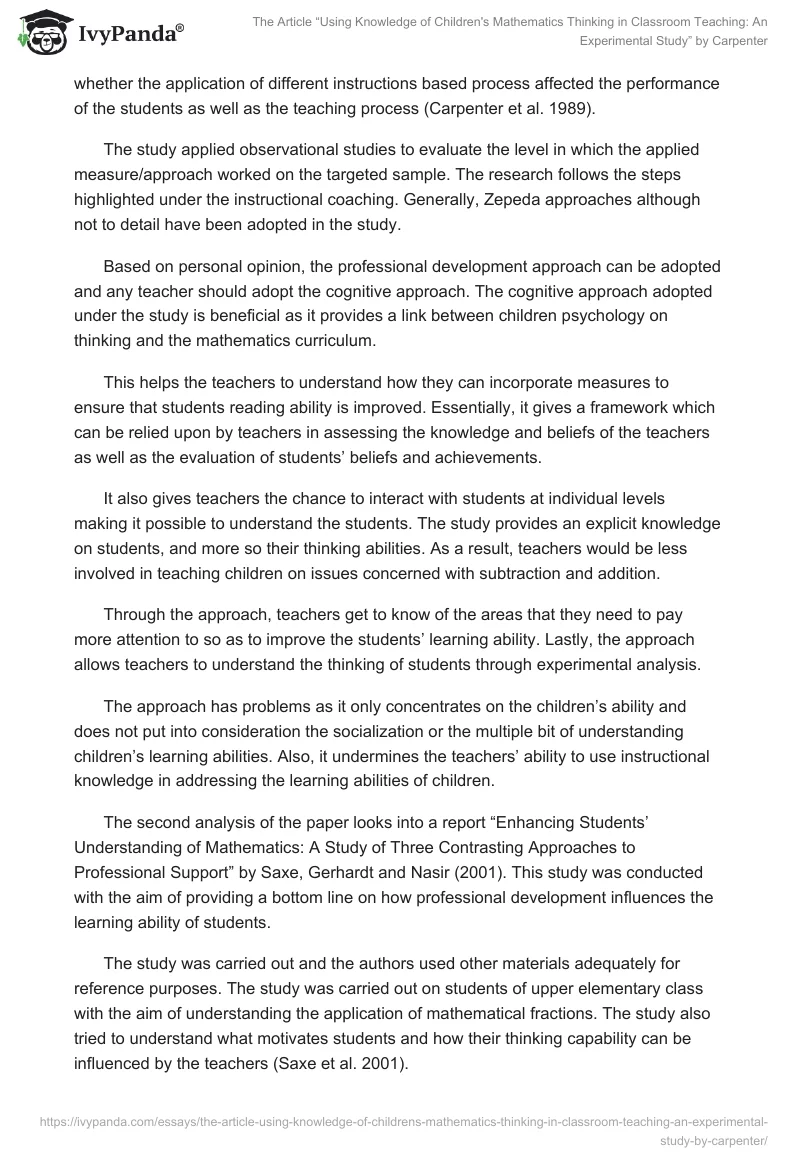Professional development (PD) has always been observed with great deal and keenness. According to Yoon, Duncan, Lee, Scarloss and Shapley (2007), over 1,300 studies have been carried out to evaluate the effectiveness of PD on teachers when adopted as a teaching method.
The essay draws its analysis from three of the nine reports which meet ‘What Works Clearinghouse evidence standards’ as suggested by Yoon et al (2007). The essay utilizes three reports in reference to the works of Sally Zepeda.
The article “Using Knowledge of Children’s Mathematics Thinking in Classroom Teaching: An Experimental Study” by Carpenter et al (1989) is an experimental study which was carried out with the intention of determining whether providing teachers with access to knowledge based on research conducted on the thinking process of children would influence the way instructions were delivered by teachers.
The study also sought to determine if this would affect the performance of children. The study is well researched and the works of other authors/researchers have been used and acknowledged. The study has adopted one of Zepeda’s approaches to professional development.
For example, it has adopted Cognitively Guided Instructions (CGI) treatment which is a modification of the cognitive coaching. Basically, the research subjected participants to subtraction and addition problems in which students thinking ability was to be evaluated. Cognitive instruction was applied with the aim of familiarizing teachers with the available research on the solutions to the problem of subtraction and addition.
The research adopted two questions which are aligned with Zepeda’s approach context and purpose. For example, the questions sought to evaluate whether the teachers involved in the study were able to understand the thinking of students and whether the application of different instructions based process affected the performance of the students as well as the teaching process (Carpenter et al. 1989).
The study applied observational studies to evaluate the level in which the applied measure/approach worked on the targeted sample. The research follows the steps highlighted under the instructional coaching. Generally, Zepeda approaches although not to detail have been adopted in the study.
Based on personal opinion, the professional development approach can be adopted and any teacher should adopt the cognitive approach. The cognitive approach adopted under the study is beneficial as it provides a link between children psychology on thinking and the mathematics curriculum.
This helps the teachers to understand how they can incorporate measures to ensure that students reading ability is improved. Essentially, it gives a framework which can be relied upon by teachers in assessing the knowledge and beliefs of the teachers as well as the evaluation of students’ beliefs and achievements.
It also gives teachers the chance to interact with students at individual levels making it possible to understand the students. The study provides an explicit knowledge on students, and more so their thinking abilities. As a result, teachers would be less involved in teaching children on issues concerned with subtraction and addition.
Through the approach, teachers get to know of the areas that they need to pay more attention to so as to improve the students’ learning ability. Lastly, the approach allows teachers to understand the thinking of students through experimental analysis.
The approach has problems as it only concentrates on the children’s ability and does not put into consideration the socialization or the multiple bit of understanding children’s learning abilities. Also, it undermines the teachers’ ability to use instructional knowledge in addressing the learning abilities of children.
The second analysis of the paper looks into a report “Enhancing Students’ Understanding of Mathematics: A Study of Three Contrasting Approaches to Professional Support” by Saxe, Gerhardt and Nasir (2001). This study was conducted with the aim of providing a bottom line on how professional development influences the learning ability of students.
The study was carried out and the authors used other materials adequately for reference purposes. The study was carried out on students of upper elementary class with the aim of understanding the application of mathematical fractions. The study also tried to understand what motivates students and how their thinking capability can be influenced by the teachers (Saxe et al. 2001).
Some of the recognized referenced works include those of Carpenter studies as analyzed above. The study adopts some of Zepeda’s approaches as it acknowledges that teachers’ professional development is formulated with the aim of transforming teachers’ practices. However, the research is not exactly related to Zepeda’s work. Nonetheless, it can be categorized under the job-embedded learning.
Job embedded learning is based on developing the career of a teacher. According to Zepeda (2012) job-embedded training is part of a teacher who executes the learned materials to the students hence becoming a culture. Practically, process like peer coaching, study groups, mentoring and reflection are adopted in the study.
In the context of job embedded training, the use of integrated mathematics assessment and collegial support are used to enhance professional development. For instance, collegial support/coaching as noted by Zepeda (2012) is an approach which offers the teachers time to reflect on instructional experiences during study process.
By learning instructions, teachers are in a better position to fully contribute to aspects which lead to improved performances. The study applies questions which are a reflection of the instructional coaching although not directly applied and executed.
From Carpenter’s study, Saxe, Gerhardt and Nasir adopt congenital guided instructions. This program as explained by Saxe et al (2001), allows teachers to apply their knowledge to enhance students perform subtraction and additional problems related to fractions.
The reasons why it would be advisable for teachers to adopt the study approaches is that based on the study teachers who had participated in the study and applied the same on students were able to promote the performance of the students. For instance, students under the CGI performed better in arithmetic and were more engaged in problem solving compared to their counterparts.
Students can better improve their performances if taught by teachers who have undergone the CGI. Students under this approach are better motivated by the teachers thus performing better and developing a positive attitude towards arithmetic problems.
The approach which uses some bit of job- embedded learning enables teachers to professionally apply the learned skills at school level to students. This enables students to learn through instructional skills which are proposed in Zepeda’s framework.
Based on the study results, the approach cannot be relied upon as a small sample was adopted and applied in the research. Therefore, it cannot be used to influence teachers to use the approaches in teaching students.
The third analysis is based on the paper, ‘Effects of the learning cycle upon student and classroom teacher performance” by Marek and Metheven (1991). The study adopted a quasi experimental design on the science subjects. Generally, the study focused on students’ conservation reasoning which was measured using the Piagetian cognitive tasks.
The study has fully acknowledged the work s of other studies in respect to professional development. However, the study does not use some of the approaches but it would fit very well in the Zepeda’s book. For example, the study can be closely fit on instructional coaching, peer coaching, and cognitive coaching (Zepeda, 2012).
For instance, the study concentrated on knowing how teachers interacted with the students, the methods adopted for teaching the students, the sequence in which teachers taught the science related studies to students, and the role teachers played in the classrooms (Marek & Metheven, 1991).
Peer coaching is evident in the study whereby students are required to engage in class tests involving observation during experimental studies. In this case, the teachers move around during experiment periods. Students are allowed to interact with their peers as part of learning process.
As applied in Zepeda’s study, the research applied the use of accumulated data from the students with the aim of inventing the subject under the study. Books study which is an approach applied by Zepeda’s is used in the study although not in detail as explained in the Zepeda’s framework. For example, science textbooks are relied heavily in analyzing the results of the class experimental studies.
Since the approaches of Zepeda’s work are not directly adopted in the study, it becomes hard to depict whether the results are presented asunder the framework in the book. However, from a personal point of view, the results are well presented in an articulate and systematic manner.
To persons who have not read the approaches discussed under this study, personal advice would be to adopt them and incorporate them in the science classes. The approach allows the students and the teachers to interact at personal level which gives the students the confidence required in learning the science subjects. Secondly, the instructional process by the teachers, allows the teacher to understand the students well as he/she best address any arising issues during the study.
It also allows students to engage in a more participatory way. Teachers who have undergone professional development are able to incorporate what they learn during seminars into classrooms and improve the performance of students.
According Marek and Matheven (1991) teachers who undergo training are able to recognize the importance of using the learning cycle as well as its ability to instill concept development, and enhance intellectual growth and development to students in elementary schools. When a teacher applies the learning cycle in classes, the students are more likely to increase their conservation reasoning prowess.
Lastly, the approach allows students to observe, interact with peers and teachers as well as manipulate objects hence improving their learning abilities. As a result, students are able to develop logical systems with enhances their intellectual thinking capacity.
The weakness of the approach is that it makes the students more dependent on the teachers and peers ability to interpret and articulate learned materials. Also, the approach cannot be applied to students’ with special needs as they require more attention from the teachers and leaving them to peers with normal learning capabilities can be devastating.
In my opinion, the results articulated apply to the area of my responsibility although the study was carried long time ago. However, the fact remains that learning cycle is a better approach which can be adopted for professional learning.
Reference List
Carpenter, T. P., Fennema, E., Peterson, P. L., Chiang, C., & Loef, M. (1989). Using knowledge of children’s mathematics thinking in classroom teaching: An experimental study. American Educational Research Journal, 26(4), 499-531.
Marek, E. A., & Methven, S. B. (1991). Effects of the learning cycle upon students and classroom teacher performance. Journal of Research in Science Teaching, 28(1), 42-53.
Saxe, G. B., Gearhart, M., & Nasir, N. S. (2001). Enhancing students’ understanding of mathematics: A study of three contrasting approaches to professional support. Journal of Mathematics Teacher Education, (4)55–79.
Yoon, K. W., Duncan, T., Lee, S. W., Scarloss, B., & Shapley. (2007). Reviewing the evidence on how teacher professional development affects student achievement. National Centre for Education Evaluation and Regional Assistance
Zepeda, S J. (2012). Professional development: What works, 2nd ed. Larchmont, NY: Eye on Education.


